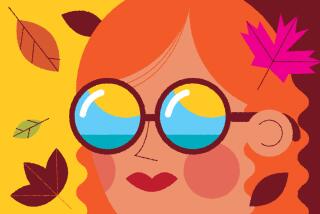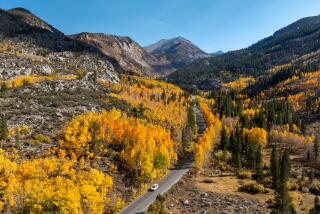Even in Southland, Fall Makes Trees Show Their True Colors
Call it the liquidambar. Or the sweet gum. Or use its botanical name, Liquidambar styraciflua.
By any name, it is one of the few trees commonly seen throughout Southern California that changes color in the fall, providing a local version of the kind of autumnal show usually associated with New England or the Midwest.
The liquidambar lines hundreds of residential areas throughout Orange County, especially in older neighborhoods, and is seen in great numbers in the hills of Santiago Canyon and Modjeska Canyon. It can grow to 50 or 60 feet, botanists say, and drops seed pods they describe as resembling “little land mines” or “those spiky balls gladiators swung around on a chain.”
There are several at Cal State Fullerton’s arboretum, the Los Angeles County Arboretum in Arcadia, Descanso Gardens in La Canada-Flintridge and at South Coast Botanic Garden in Rolling Hills Estates. UC Riverside also has a botanic garden with its share of liquidambar.
Normally, they would be changing color by now, the area’s botanists, landscape architects and other plant experts agree, but an unusually warm October has delayed this year’s performance.
Still, the point is that Southern Californians don’t have to go to Vermont or Missouri to see leaves change color.
“There is a multitude of trees out here,” said David Walkington, director of the Cal State Fullerton Arboretum. “They don’t provide the spectacular color changes that you would see in areas like the East, where they have sugar maples, for example. But sugar maples don’t do well in our mild Mediterranean climate.”
The liquidambar isn’t a California native, either, he said. It normally grows in the eastern half of the United States and is generally only seen about as far west as Missouri.
Other local trees and shrubs also provide some seasonal change. Weeping willows turn yellow, landscape architect Greg Meek from the city of Fullerton points out, and sycamores “brown out.” Aspen and alder leaves turn yellow before they fall.
The silver leaf, Japanese and big leaf maple--all common to the area--provide some color change, and the ginkgo turns a bright yellow. The black walnut keeps many of its leaves year-round but experiences a yellowing of those that do remain.
Where are these local trees? Everywhere, those who know the subject agree, but some areas are particularly nice for a weekend drive or walk.
* Bob Cruz, field superintendent for the city of Orange parks department’s street trees divisions, says that city’s Adams Avenue, between the 900 and 1200 block, has “some majestic liquidambars.”
* Meek, from Fullerton, says Highland Avenue, near City Hall, is lined with liquidambars. The city’s Hillcrest Park, on Harbor Boulevard, also has a number of trees that undergo autumnal changes.
* Walkington believes a drive east on Chapman Avenue in Orange into Santiago Canyon and toward Silverado and Modjeska Canyon provides the best show. In addition to the liquidambars, the area is filled with sycamores, poplars, aspens and alders (which undergo some color change), and pear trees, which, while officially evergreens, sometimes put on a pretty good show.
What causes the color changes? Why do trees go to all that trouble when they’re only going to grow new leaves in March?
Dan Jundanian, a biology teacher at Fullerton’s Troy High School and a naturalist for the city of Anaheim, explains that the color change isn’t truly a change at all. The oranges and yellow and browns have been there all the time, but they have been masked by other colors.
“A layer of cells begins to form across the bottom of the leaf,” Jundanian says. “As it does so, it cuts off the nutrients which have been feeding the leaf. As it uses up its stored sugars and starches, the leaf begins to fade, and the less predominant pigments--the reds, yellows and browns--become more visible.”
All deciduous trees, those that shed their leaves, go through this process in the autumn, but not at the same time or with the same intensity.
Since trees don’t know what month it is, something else must let them know that it’s time to start dropping leaves and changing colors. The two contributing factors are usually colder temperatures and less daylight.
“We’ve had such a warm October that the changing process has been slowed,” Walkington said, “but it ordinarily is the onset of colder nights that starts the process that brings about the color change.”
Even if the temperature were to remain constant, he said, the trees would begin to show some color change because the lengthening of the hours of darkness is part of the rhythm cycle to which they react.
Ordinarily, the color change starts early in October and continues through November and sometimes into December, by which time the leaves have fallen. Meek said that, because of the area’s mild winters, budding begins as early as March, “really a fairly short period of winter for a deciduous tree.”
Jundanian suggests that Orange County residents eager to see a splash in color can head into the San Bernardino Mountains, where the higher altitudes have already brought about some colder nights and, with them, a golden hue to the liquidambar.
Higher elevations, and consequently cooler temperatures, in Orange County’s interior parks also may offer an earlier autumnal change. Sites that may offer color changes soon include Caspers Regional Park, on Ortega Highway in San Juan Hot Springs; O’Neill Regional Park, on Trabuco Canyon Road in Trabuco Canyon; Santiago Oaks Regional Park, on Hewes Street in Orange; and Irvine Regional Park, on Chapman Avenue, east of Orange.
In Los Angeles County, Descanso Gardens is at 1418 Descanso Drive in La Canada-Flintridge; South Coast Botanic Garden is at 26300 Crenshaw Blvd. in Rolling Hills Estates, and the Los Angeles County Arboretum is at 301 N. Baldwin Ave. in Arcadia. Officials there reported early this week that only the ginkgo has begun to change color.
Cal State Fullerton’s Walkington enjoys what he calls the “urban forest” of Southern California. The autumn colors aren’t as striking as in other parts of the nation, “but it’s interesting to see the ‘urban forest’ of trees, planted throughout our cities. So many were brought here from other states, other countries, to provide shade, fruit or a memory of places people were leaving behind.”
More to Read
Sign up for The Wild
We’ll help you find the best places to hike, bike and run, as well as the perfect silent spots for meditation and yoga.
You may occasionally receive promotional content from the Los Angeles Times.






